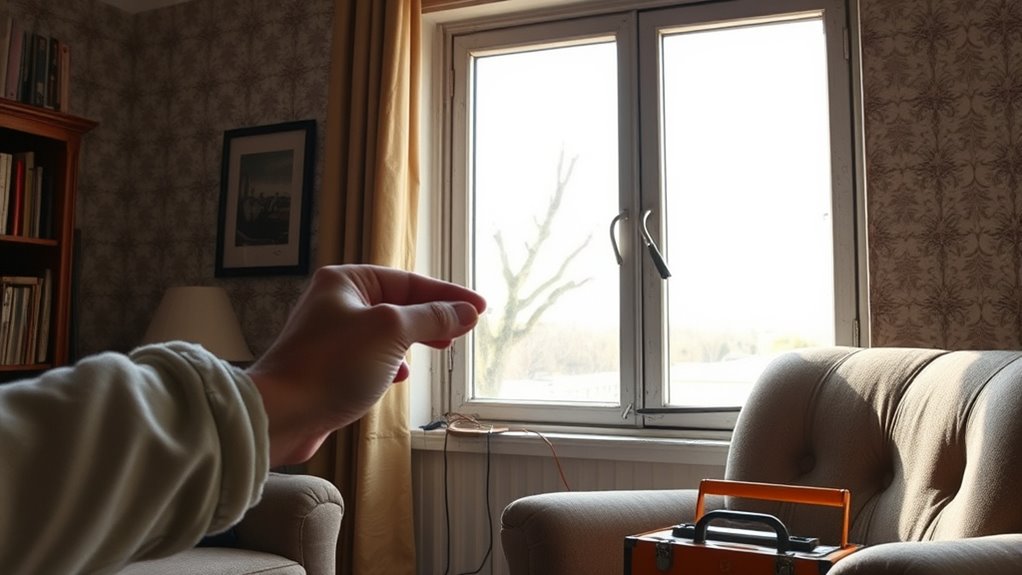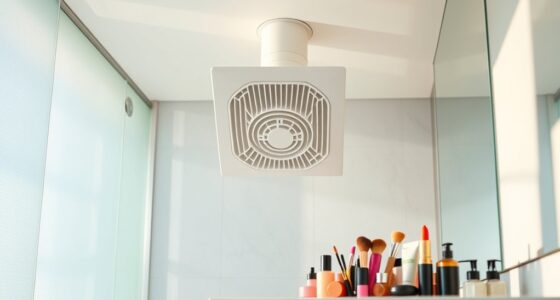To quickly fix a drafty room, start by inspecting windows, doors, outlets, moldings, and attic access points for gaps. Use the candle test or feel for leaks, and seal gaps around windows, doors, and electrical outlets with weatherstripping, caulk, or foam. Install door sweeps and draft stoppers on exterior doors, and add insulation to key areas. For detailed tips to stop sneaky leaks fast, keep going—there’s more you can do.
Key Takeaways
- Inspect windows, doors, and electrical outlets using the candle flicker or incense test to locate hidden leaks quickly.
- Seal gaps around window frames, door thresholds, outlets, and moldings with weatherstripping, caulk, or foam sealant.
- Install door sweeps and draft stoppers at exterior doors and low-entry points to block cold drafts immediately.
- Add insulation to problem areas like attics, basements, and around fixtures to prevent heat loss.
- Perform a final airtightness check with a flashlight or incense to ensure all leaks are effectively sealed.
Inspect Windows and Doors for Gaps

Have you ever noticed chilly drafts around your windows and doors? The first step is to inspect these areas carefully. Check for window gaps where you can feel air slipping through. Pay attention to the edges of the window frames and sashes. Similarly, examine your door seals—are they intact and snug? Look for cracks or tears in the weatherstripping and replace any damaged parts. Sometimes, gaps are small but still allow significant air leakage. Use your hand to feel for drafts or hold a lightweight ribbon near the gaps to see if it moves. Addressing these issues early on can drastically reduce unwanted air infiltration and improve your room’s comfort. Sealing these gaps helps keep your home warmer and energy bills lower. Additionally, applying security measures like reinforced door seals can further enhance your home’s protection against intruders.
Use the Candle Test to Detect Air Leaks

To check for drafts, you can use the candle test by carefully moving a lit candle around potential trouble spots. Watch for flickering, which indicates air is flowing past the flame. Understanding how to interpret the candle’s movement helps you pinpoint where leaks are hiding. Incorporating soundscapes into your testing can also help identify drafts by amplifying the air movement sounds.
Candle Test Procedure
A simple way to identify leaks around windows and doors is by performing the candle test. First, ensure candle safety by keeping the flame steady and away from curtains or drapes. To get accurate results, perform the test during ideal testing times—preferably on a windy or breezy day when air movement is more noticeable. Light the candle and hold it steadily about a foot from the edges of the window or door frame. Slowly move the candle around the perimeter, watching for flickering or movement in the flame. A flicker indicates a draft. Be patient and cautious, especially if you’re testing multiple areas. Remember, this simple test helps you quickly locate sneaky leaks without expensive equipment. Using a smoke stick or incense can also be an effective alternative to detect air leaks more precisely.
Interpreting Candle Flicker
When you observe the candle flame flickering during the test, it indicates that air is moving around the window or door frame. A steady flame means minimal air flow, while a flickering flame signals drafts. Pay attention to the direction of the flicker, which can help locate the precise leak. If the candle flicker is constant or erratic, it suggests a significant air leak. Use this visual cue to identify problem areas quickly. Remember, even small air flows can cause noticeable flickering. To improve accuracy, conduct the test on a calm day, as wind can affect the candle’s behavior. Regularly observing the candle flicker helps you pinpoint leaks and prioritize sealing efforts effectively. This simple method saves time and money in draft detection and correction. Additionally, understanding the environmental factors that influence candle behavior can improve your detection accuracy.
Examine Electrical Outlets and Switches
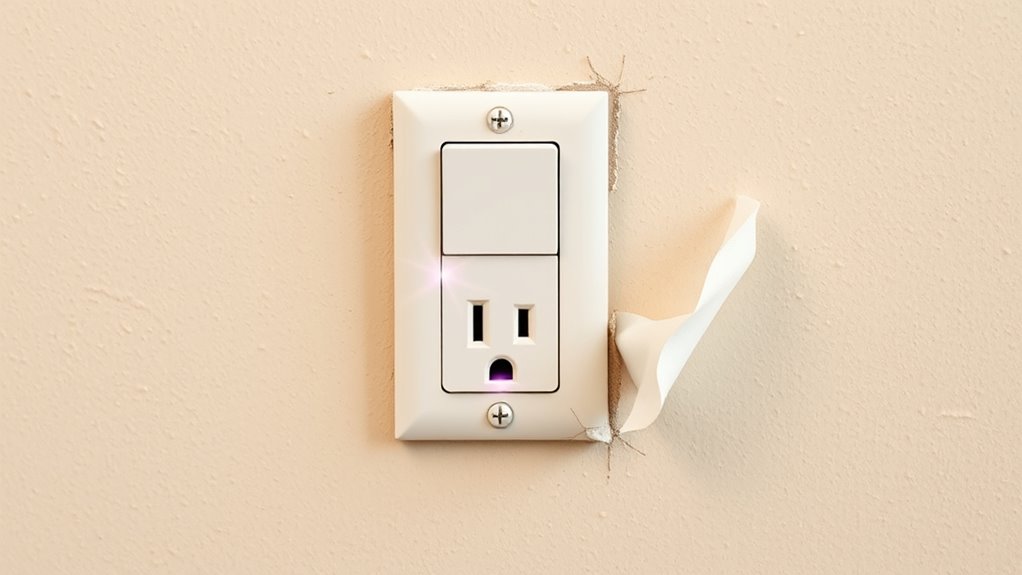
Are you noticing drafts near your electrical outlets and switches? These small gaps can let cold air slip into your room unnoticed. To check, turn off the power and carefully remove the faceplates from your outlets and switches. Feel around the edges for any air leaks. If you find drafts, use foam gaskets designed for outlets and switches—they’re simple to install and effective. For larger gaps, consider sealing them with expanding foam or caulk. Make sure to turn the power back on after sealing. Sealing these tiny openings can make a noticeable difference in your room’s comfort and energy efficiency. Don’t overlook this quick fix—it’s an easy way to stop sneaky drafts and keep your space warmer.
Check for Leaks Around Baseboards and Crown Moldings
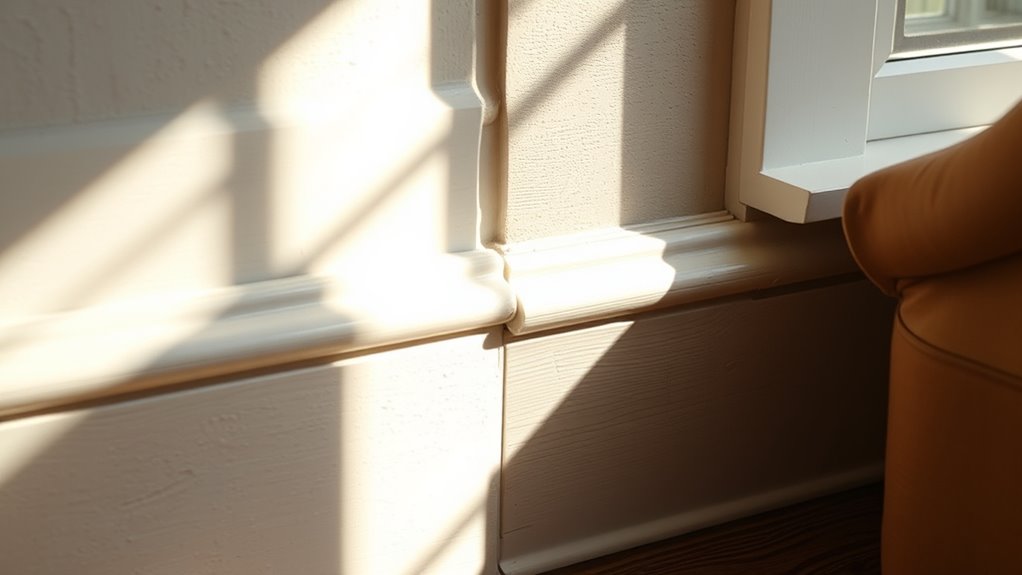
Since gaps around baseboards and crown moldings can let warm air escape and cold drafts in, it’s important to inspect these areas carefully. Decorative molding and baseboard design often create small cracks that let air seep through. Check along the edges where the molding meets the wall and floor for visible gaps or cracks. Feel for drafts by holding a lighted incense stick or your hand near these areas. Sealing these leaks improves energy efficiency and comfort. Regularly assessing and rotating your home’s organization items can help maintain a clutter-free environment that supports overall home efficiency. Use caulk or weatherstripping for a snug seal. Pay attention to intricate or ornate decorative molding, as these often have hidden gaps.
Assess Attic and Basement Access Points

Start by checking your attic entry for gaps or loose insulation that could let drafts in. Then, examine your basement doors for proper sealing and tight fit. Addressing these access points can make a noticeable difference in reducing drafts.
Inspect Attic Entry Points
Inspecting attic and basement access points is an essential step in identifying potential drafts that may be letting outside air into your home. Focus on your attic entry, as gaps here can considerably impact indoor temperature. Check for gaps around the attic hatch or pull-down stairs, sealing them with weatherstripping or caulk. Proper attic insulation and ventilation help prevent drafts, so ensure insulation isn’t compressed or damaged near access points. A well-sealed hatch prevents air leaks, maintaining energy efficiency. Additionally, assessing Gold IRA Rollovers can inform future financial planning that supports energy-efficient home upgrades.
Examine Basement Doors
Examining basement doors is a key step in identifying drafts that can affect your home’s energy efficiency. Check the edges of your basement door for gaps or cracks where air infiltration might occur. Feel for cold drafts or observe light sneaking through small openings. A door that doesn’t seal properly allows warm air to escape and cold air to enter, increasing your heating bills. Ensure the door fits snugly within its frame and look for worn weatherstripping or gaps. If you notice any leaks, replace or add weatherstripping to improve the seal. Sealing basement doors effectively prevents unwanted air infiltration, making your home more comfortable and energy-efficient. Regular inspections help catch leaks early, saving you money and hassle in the long run. Proper sealing also helps reduce the strain on your heating and cooling system by minimizing air leaks, improving overall home comfort.
Seal Gaps With Caulk or Weatherstripping

To effectively seal drafts, you should focus on filling gaps around windows and doors with caulk or weatherstripping. Air leak detection helps identify where drafts enter, ensuring you target the right spots. Using appropriate sealing materials creates a tight barrier, improving energy efficiency. When choosing sealing materials, consider the size and location of gaps for the best results. Remember, properly sealed gaps prevent heat loss and reduce your energy bills. Additionally, understanding the differences between sealing options such as caulk and weatherstripping can help you select the most effective method for each area.
Install Door Sweeps on Exterior Doors
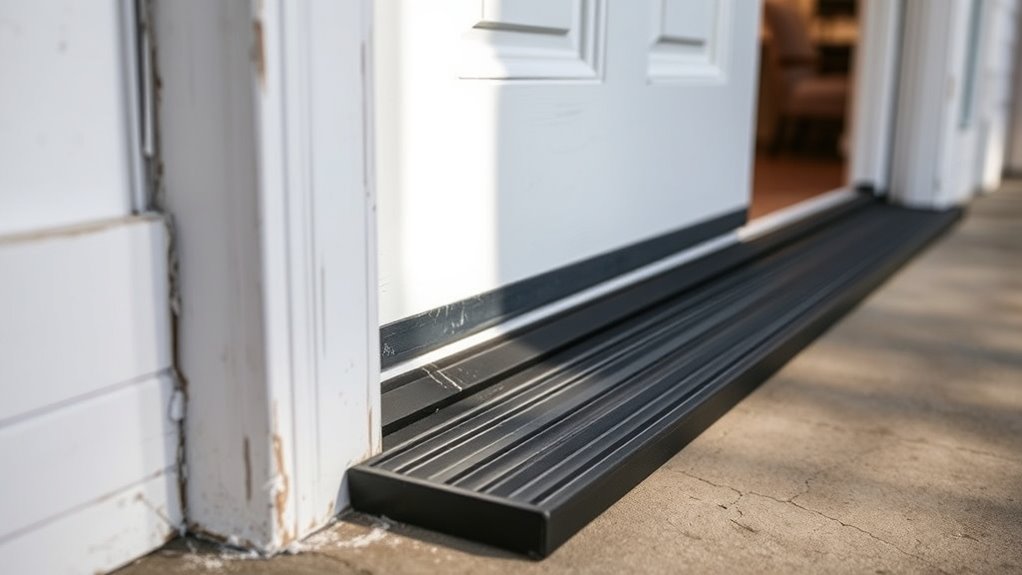
Installing door sweeps on exterior doors is an effective way to block drafts that slip under the threshold. Door sweep installation is straightforward and provides an immediate boost to exterior door sealing. First, measure your door’s width to choose the right size. Next, clean the door’s bottom edge thoroughly to ensure a good seal. Then, attach the sweep using screws or adhesive, depending on the type. Make sure the sweep’s rubber or bristle side touches the threshold to prevent air leaks. Proper installation guarantees a tight fit, reducing drafts and improving energy efficiency. Regularly check and replace worn or damaged door sweeps to maintain ideal exterior door sealing. Additionally, selecting the right door sweep material can enhance durability and effectiveness. This simple step can noticeably cut down on cold air sneaking in, making your home more comfortable and energy-efficient.
Use Draft Snakes or Draft Stoppers

Using draft snakes or draft stoppers is an easy and effective way to block cold air from entering your home through doorways and windows. A draft snake, often a fabric tube filled with insulating material, can be placed at the base of doors or windows to seal gaps quickly. Similarly, a draft stopper is a simple barrier that prevents drafts from sneaking inside. These inexpensive solutions are portable and reusable, making them perfect for seasonal use. When choosing a draft snake or draft stopper, consider the size and fit to ensure maximum coverage. Proper placement is key to blocking leaks effectively. Using these tools helps reduce heat loss and keeps your home more comfortable without complicated repairs. Additionally, sealing air leaks is important because air leaks can also contribute to increased energy bills and decreased home comfort.
Improve Insulation in Problem Areas
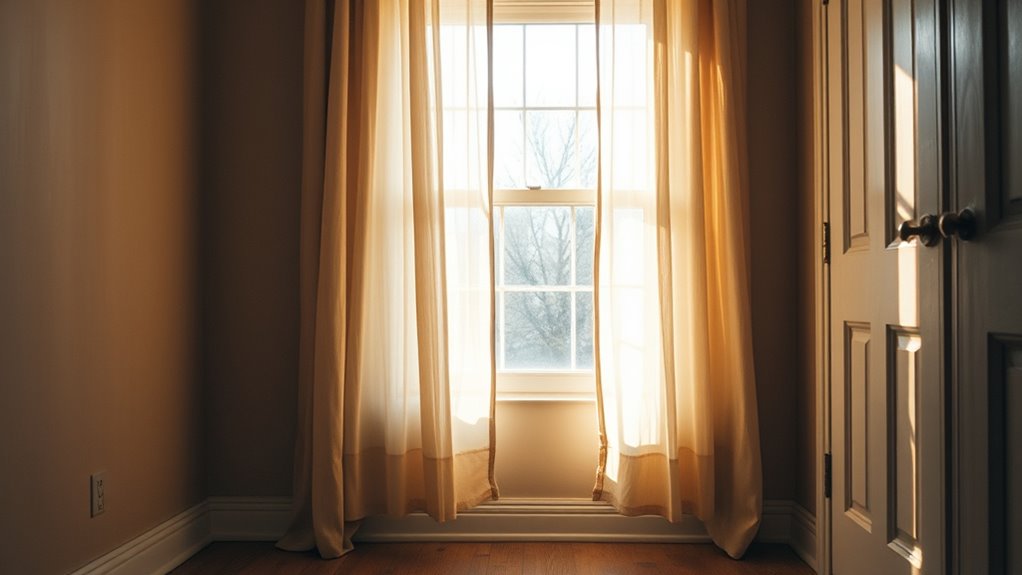
If certain areas in your home feel especially drafty or chilly, improving insulation there can make a big difference. Adding or upgrading thermal barriers helps prevent warm air from escaping and cold air from seeping in. Focus on problem spots like attic spaces, walls, and basement ceilings. Use effective insulation materials such as fiberglass batts, spray foam, or foam boards to fill gaps and voids. Proper insulation not only reduces drafts but also enhances overall energy efficiency. Be sure to install insulation tightly against surfaces and around fixtures, ducts, or wiring to eliminate hidden air leaks. Improving insulation in these areas creates a more consistent indoor temperature and makes your home more comfortable year-round. Effective insulation materials play a crucial role in sealing leaks and maintaining desired indoor temperatures.
Perform a Final Check and Fine-Tune Seals
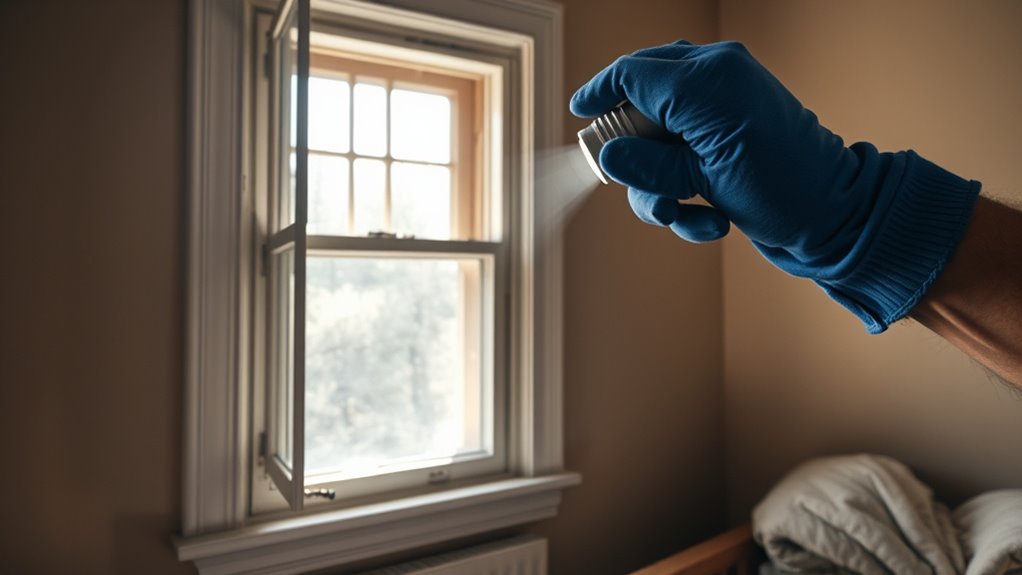
Before wrapping up your drafty room fix, it’s important to perform a thorough final check and fine-tune your seals. Inspect the room carefully, paying attention to airflow patterns that may reveal overlooked leaks. Use a flashlight or incense stick to identify any drafts that persist. When sealing, consider various sealant options like weatherstripping, caulk, or foam sealant, choosing the right one for each gap. Fine-tuning ensures ideal airflow control and prevents future leaks. Remember, small leaks can considerably impact comfort and energy efficiency. Take your time to recheck all sealed areas, ensuring they’re airtight and secure. Properly fine-tuned seals will keep drafts out and indoor temperatures stable, saving you money on heating and cooling costs. Ensuring your seals are properly maintained can further enhance the effectiveness of your draft prevention efforts.
Frequently Asked Questions
How Do I Identify Hidden Air Leaks Behind Walls?
You can identify hidden air leaks behind walls by performing an insulation inspection and drywall inspection. Turn off your HVAC system and hold a lit incense stick or a tissue near wall seams, electrical outlets, and switches; if the smoke or tissue moves, you’ve found a leak. You might also use a thermal camera to spot temperature differences indicating drafts, helping you locate and seal those sneaky air leaks effectively.
What Are the Best Materials for Sealing Tiny Cracks?
Think of tiny cracks as tiny holes in a boat; even the smallest leak can sink it. For sealing these, caulking alternatives like weatherstripping or acrylic latex work well, but foam sealants are especially good for gaps that are hard to reach or irregularly shaped. They expand to fill cracks completely, ensuring no sneaky air leaks escape. Use them for a tight, long-lasting seal.
Can Weatherstripping Be Used on Uneven Door Frames?
Yes, weatherstripping can be used on uneven door frames, but you’ll want to choose options with good door frame insulation and high weatherstripping durability. Flexible foam or V-strip weatherstripping works well because they conform to irregular surfaces, sealing gaps effectively. Make sure to select a product designed for uneven surfaces to guarantee a tight seal that keeps drafts out and maintains energy efficiency.
How Often Should I Recheck for Drafts After Sealing?
After sealing, you should check for drafts every few weeks to make sure your fix is holding. Regular rechecks help spot new leaks early, especially after insulation upgrades or HVAC adjustments. Stay vigilant and verify vents, windows, and door seals, and reapply weatherstripping or sealant as needed. Consistent checks keep your home cozy, conserving energy, and preventing pesky drafts from sneaking back in.
Are There Eco-Friendly Options for Sealing Leaks?
Yes, you can choose eco-friendly sealants like soy-based or natural latex caulks, and biodegradable tapes made from plant fibers. These options work effectively to seal leaks while being gentle on the environment. They emit fewer VOCs and break down naturally over time. When sealing air leaks, opt for these eco-conscious products to reduce your carbon footprint and keep your home comfortable without compromising sustainability.
Conclusion
Now that you’ve sealed those sneaky leaks, your room will feel warmer and more comfortable. Remember, a drafty space isn’t just chilly—it can also waste energy and increase bills. Are you ready to enjoy a cozier, more efficient home? With these quick fixes, you’ve taken a big step toward a warmer, draft-free environment. Keep up the good work, and don’t let those pesky leaks creep back in!
